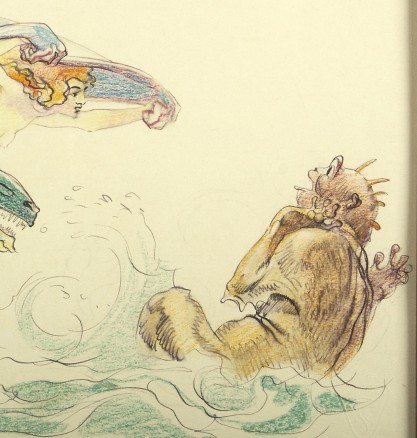


In this whimsically imaginative drawing from the German expressionist and Jugendstil artist Heinrich Kley, a nude water nymph, whose form and pose evoke Venus, frightens away a sea demon as her consort, a dolphin of sorts, looks on laughing. In this mixed medium detailed work, Kley inverts the viewers expectation of women’s sensuality in a unique dark and satirical style. With this as an example, it’s easy to see why Walt Disney collected Kley and relied on similar images for some of the animation sequences in Fantasia. A rare full color rendering on blind-stamped artists paper, most of Kley’s surviving pieces are black and white pen & ink drawings. Framed in a fabulous ornate cornered hand carved basswood museum quality frame silk matted behind glass.



Heinrich Kley is best remembered today for satirical, despairing, and often obscene images which evinced a maniacal distrust of the industrial revolution and its automatized society. In 1907, a series of remarkable pen & ink drawings appeared in the Munich German Expressionist literary art magazine Die Jugend that captured the growing disillusionment of fin-de-siecle German counter-culture. Kley’s scathing and deftly rendered creations resonated with audiences and Kley became a leading interpreter of the follies and vices that beset mankind. Kley’s art appeared in the United States in 1937 and caught the eye of Walt Disney & Sketch Artists at the Disney studio, including Albert Hurter, Joe Grant, and James Bodrero. Hurter introduced Kley’s work to the Disney Studio and Walt Disney accumulated a collection of the artist’s work. The images in Kley’s art inspired a number of animated sequences and characters, including Night on Bald Mountain and the dancing animals of Dance of the Hours in Fantasia.
In 1947 the “Drawings of Heinrich Kley” was published with a forward by George Grosz. Of Kley, Grosz wrote: “Kley used the pen like the lariat of a temperamental cowboy [and] is a great draftsman of animals. Like Walt Disney he humanizes the beasts […] I am sure that the drawings of Heinrich Kley will be remembered and enjoyed as long as human beings retain the ability to laugh at themselves.”
